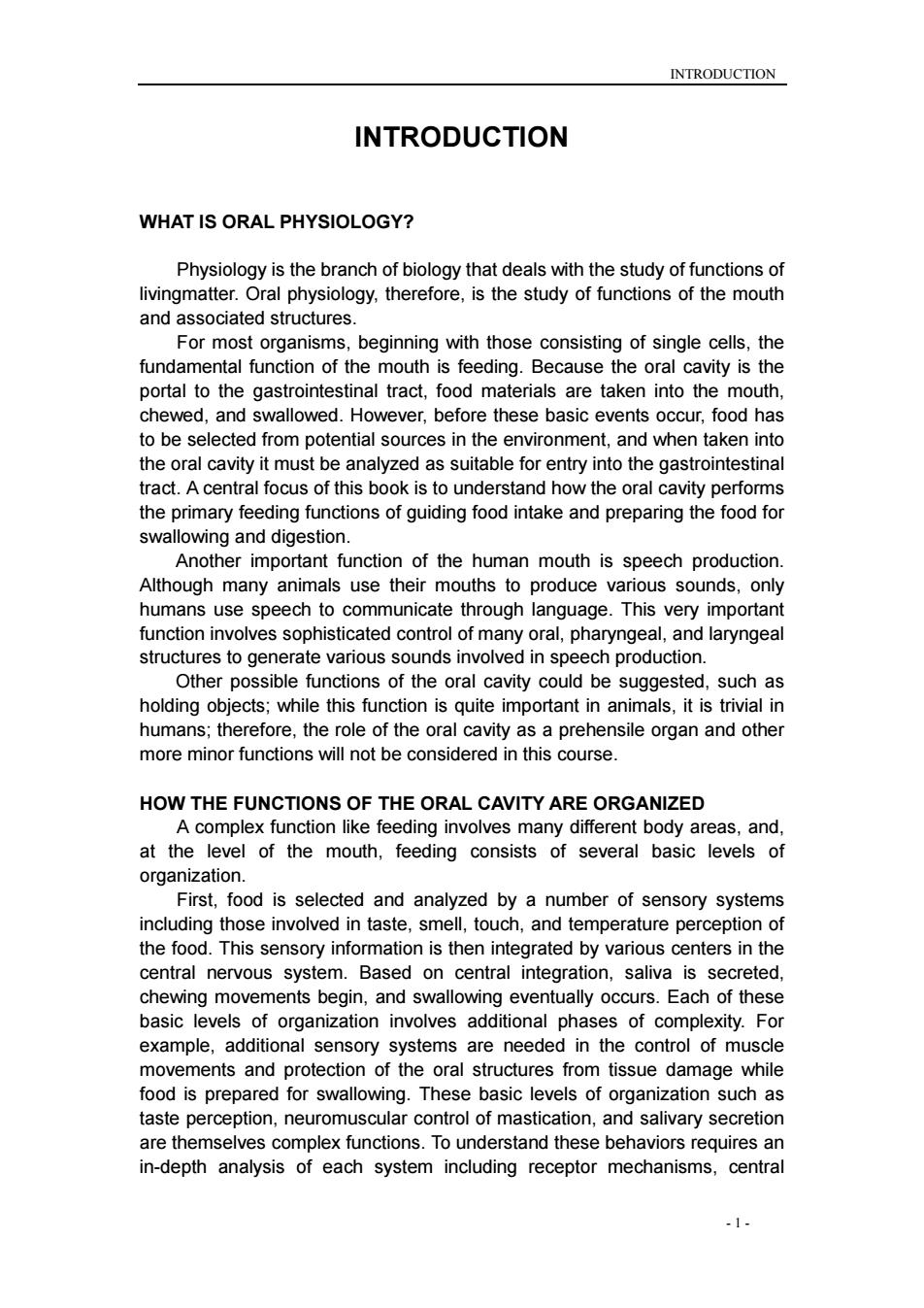正在加载图片...

INTRODUCTION INTRODUCTION WHAT IS ORAL PHYSIOLOGY? Physiology is the branch of biology that deals with the study of functions of livingmatter.ral is the study of functions of the mouth and structures. For most organisms,beginning with those consisting of single cells,the fundamental function of the mouth is feeding.Because the oral cavity is the portal to the gastrointestinal tract,food materials are taken into the mouth. and swallowed.However,before these basic events occur,food has le rompt sources inte envromenann ta in the oral cavity it must be analyzed as suitable for entry into the gastrointestinal tract.A central focus of this book is to understand how the oral cavity performs the primary feeding functions of guiding food intake and preparing the food for swallowing and digestion. Another important function of the human mouth is speech production Although many animals use their mouths to produce various sounds,only humans use speech to communicate through language.This very important function involves sophisticated control of many oral,pharyngeal,and laryngeal structures to generate various sounds involved in speech production. humans;therefore,the role of the oral cavity as a prehensile organ and other more minor functions will not be considered in this course. HOW THE FUNCTIONS OF THE ORAL CAVITY ARE ORGANIZED mplex ction like fe ding involves many different b dy areas,and at the level of the mouth,feeding consists of several basic levels of organization. First,food is selected and analyzed by a number of sensory systems including those involved in taste,smell,touch,and temperature perception of enters in the central nervous system.Based on central integration,saliva is secreted. chewing movements begin,and swallowing eventually occurs.Each of these basic levels of organization involves additional phases of complexity.For example,additional sensory systems are needed in the control of muscle rotect of the oral struct om tissue rereor walling.These basic levelsof ee fr dar while taste perception,neuromuscular control of mastication,and salivary secretion are themselves complex functions.To understand these behaviors requires an in-depth analysis of each system including receptor mechanisms,central -1-INTRODUCTION - 1 - INTRODUCTION WHAT IS ORAL PHYSIOLOGY? Physiology is the branch of biology that deals with the study of functions of livingmatter. Oral physiology, therefore, is the study of functions of the mouth and associated structures. For most organisms, beginning with those consisting of single cells, the fundamental function of the mouth is feeding. Because the oral cavity is the portal to the gastrointestinal tract, food materials are taken into the mouth, chewed, and swallowed. However, before these basic events occur, food has to be selected from potential sources in the environment, and when taken into the oral cavity it must be analyzed as suitable for entry into the gastrointestinal tract. A central focus of this book is to understand how the oral cavity performs the primary feeding functions of guiding food intake and preparing the food for swallowing and digestion. Another important function of the human mouth is speech production. Although many animals use their mouths to produce various sounds, only humans use speech to communicate through language. This very important function involves sophisticated control of many oral, pharyngeal, and laryngeal structures to generate various sounds involved in speech production. Other possible functions of the oral cavity could be suggested, such as holding objects; while this function is quite important in animals, it is trivial in humans; therefore, the role of the oral cavity as a prehensile organ and other more minor functions will not be considered in this course. HOW THE FUNCTIONS OF THE ORAL CAVITY ARE ORGANIZED A complex function like feeding involves many different body areas, and, at the level of the mouth, feeding consists of several basic levels of organization. First, food is selected and analyzed by a number of sensory systems including those involved in taste, smell, touch, and temperature perception of the food. This sensory information is then integrated by various centers in the central nervous system. Based on central integration, saliva is secreted, chewing movements begin, and swallowing eventually occurs. Each of these basic levels of organization involves additional phases of complexity. For example, additional sensory systems are needed in the control of muscle movements and protection of the oral structures from tissue damage while food is prepared for swallowing. These basic levels of organization such as taste perception, neuromuscular control of mastication, and salivary secretion are themselves complex functions. To understand these behaviors requires an in-depth analysis of each system including receptor mechanisms, central